Answered step by step
Verified Expert Solution
Question
1 Approved Answer
After reading the article below identify and briefly discuss each of the following key takeaways key criticisms/oversights, how what youve read might be implemented into
After reading the article below identify and briefly discuss each of the following
-
key takeaways
-
key criticisms/oversights,
-
how what youve read might be implemented into daily business practices
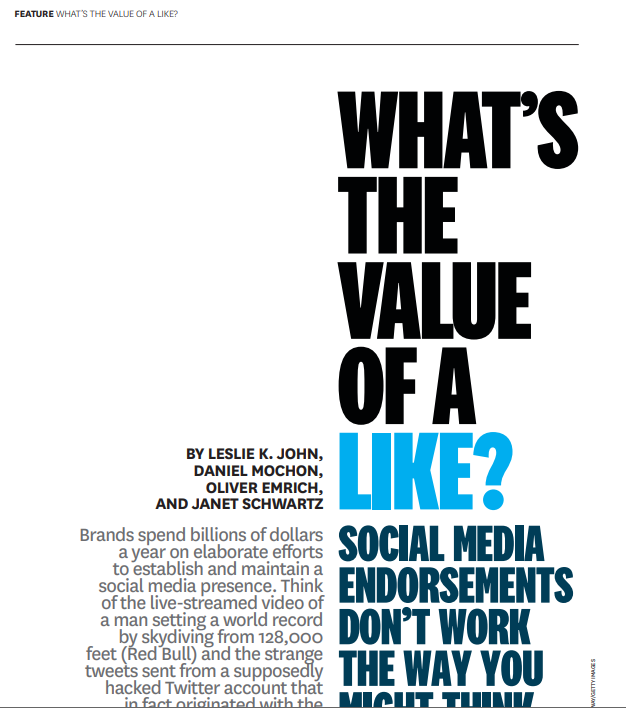
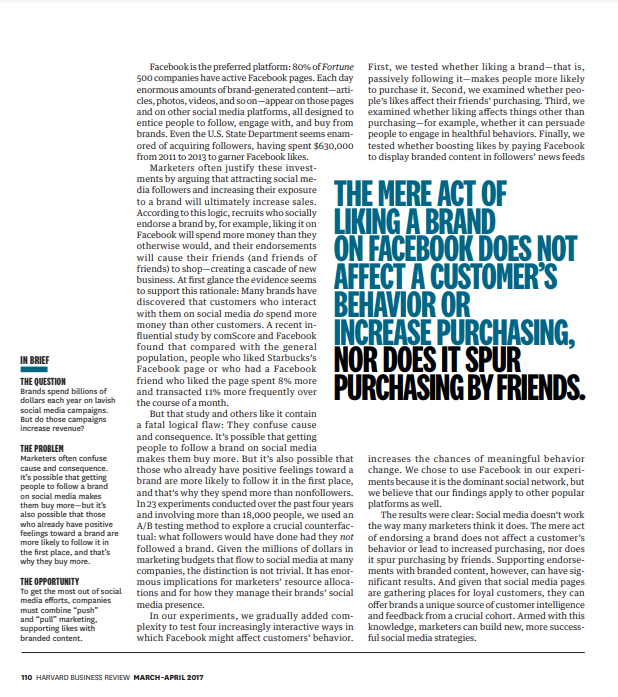
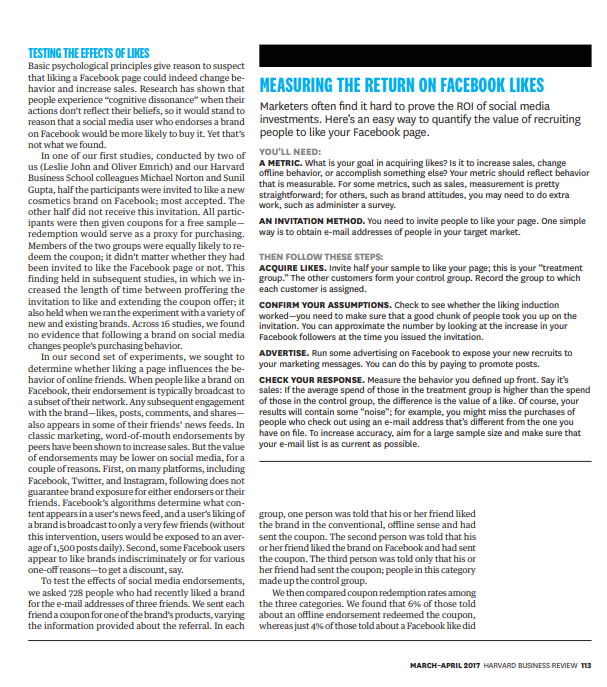
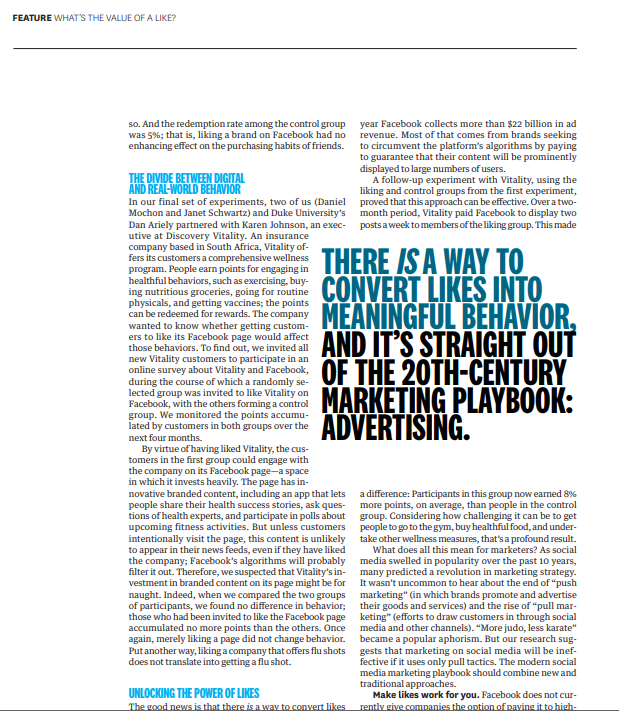
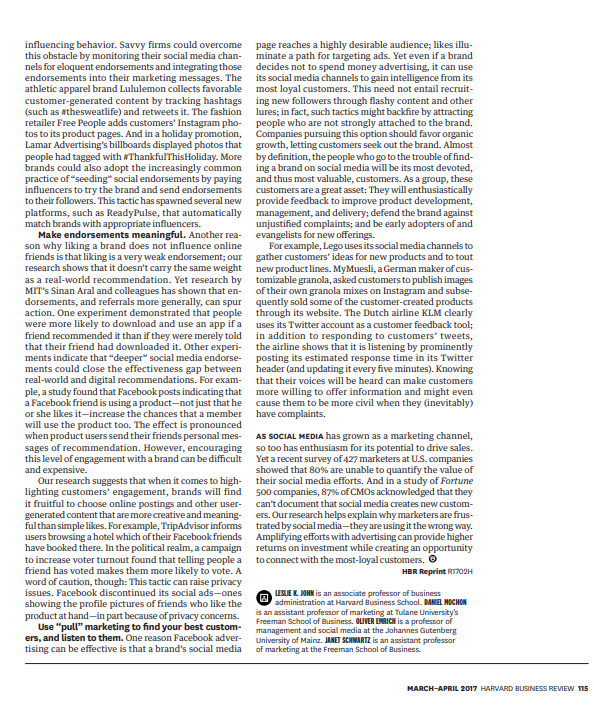
FEATURE WHAT'S THE VALUE OF A LIKE? WHAT'S THE VALUE OF A LIKE? BY LESLIE K. JOHN, DANIEL MOCHON, OLIVER EMRICH, AND JANET SCHWARTZ Brands to and social media presence. Think a year on elaborate efforts SOCIAL MEDIA ENDORSEMENTS of the of a man setting a world record DON'T WORK by skydiving from 128,000 tweets sent from a supposedly THE WAY YOU hacked Twitter in fact originated with the CUT TULIZ WAY/GETTY IMAGES Facebook is the preferred platform: 80% of Fortune 500 companies have active Facebook pages. Each day enormous amounts of brand-generated content-arti- cles, photos, videos, and so on-appear on those pages and on other social media platforms, all designed to entice people to follow, engage with, and buy from brands. Even the U.S. State Department seems enam- ored of acquiring followers, having spent $630,000 from 2011 to 2013 to garner Facebook likes. Marketers often justify these invest- ments by arguing that attracting social me- dia followers and increasing their exposure to a brand will ultimately increase sales. According to this logic, recruits who socially endorse a brand by, for example, liking it on Facebook will spend more money than they otherwise would, and their endorsements will cause their friends (and friends of friends) to shop-creating a cascade of new business. At first glance the evidence seems to support this rationale: Many brands have discovered that customers who interact with them on social media do spend more money than other customers. A recent in- fluential study by comScore and Facebook found that compared with the general population, people who liked Starbucks's Facebook page or who had a Facebook friend who liked the page spent 8% more and transacted 11% more frequently over the course of a month. But that study and others like it contain a fatal logical flaw: They confuse cause and consequence. It's possible that getting people to follow a brand on social media makes them buy more. But it's also possible that those who already have positive feelings toward a brand are more likely to follow it in the first place, and that's why they spend more than nonfollowers. In 23 experiments conducted over the past four years and involving more than 18,000 people, we used an A/B testing method to explore a crucial counterfac- tual: what followers would have done had they not followed a brand. Given the millions of dollars in marketing budgets that flow to social media at many companies, the distinction is not trivial. It has enor- mous implications for marketers' resource alloca- tions and for how they manage their brands' social media presence. In our experiments, we gradually added com- plexity to test four increasingly interactive ways in which Facebook might affect customers' behavior. First, we tested whether liking a brand-that is, passively following it-makes people more likely to purchase it. Second, we examined whether peo- ple's likes affect their friends' purchasing. Third, we examined whether liking affects things other than purchasing-for example, whether it can persuade people to engage in healthful behaviors. Finally, we tested whether boosting likes by paying Facebook to display branded content in followers' news feeds THE MERE ACT OF LIKING A BRAND ON FACEBOOK DOES NOT AFFECT A CUSTOMER'S BEHAVIOR OR INCREASE PURCHASING, NOR DOES IT SPUR PURCHASING BY FRIENDS. increases the chances of meaningful behavior change. We chose to use Facebook in our experi- ments because it is the dominant social network, but we believe that our findings apply to other popular platforms as well. The results were clear: Social media doesn't work the way many marketers think it does. The mere act of endorsing a brand does not affect a customer's behavior or lead to increased purchasing, nor does it spur purchasing by friends. Supporting endorse- ments with branded content, however, can have sig- nificant results. And given that social media pages are gathering places for loyal customers, they can offer brands a unique source of customer intelligence and feedback from a crucial cohort. Armed with this knowledge, marketers can build new, more success- ful social media strategies. IN BRIEF THE QUESTION Brands spend billions of dollars each year on lavish social media campaigns. But do those campaigns increase revenue? THE PROBLEM Marketers often confuse cause and consequence. It's possible that getting people to follow a brand on social media makes them buy more-but it's also possible that those who already have positive feelings toward a brand are more likely to follow it in the first place, and that's why they buy more. THE OPPORTUNITY To get the most out of social media efforts, companies must combine "push" and "pull" marketing. supporting likes with branded content. 110 HARVARD BUSINESS REVIEW MARCH-APRIL 2017 TESTING THE EFFECTS OF LIKES Basic psychological principles give reason to suspect that liking a Facebook page could indeed change be- MEASURING THE RETURN ON FACEBOOK LIKES increase has shown that people experience "cognitive dissonance" when their actions don't reflect their beliefs, so it would stand to reason that a social media user who endorses a brand on Facebook would be more likely to buy it. Yet that's not what we found. Marketers often find it hard to prove the ROI of social media investments. Here's an easy way to quantify the value of recruiting people to like your Facebook page. YOU'LL NEED: In one of our first studies, conducted by two of us (Leslie John and Oliver Emrich) and our Harvard Business School colleagues Michael Norton and Sunil A METRIC. What is your goal in acquiring likes? Is it to increase sales, change offline behavior, or accomplish something else? Your metric should reflect behavior that is measurable. For some metrics, such as sales, measurement is pretty straightforward; for others, such as brand attitudes, you may need to do extra work, such as administer a survey. AN INVITATION METHOD. You need to invite people to like your page. One simple way is to obtain e-mail addresses of people in your target market. THEN FOLLOW THESE STEPS: Gupta, half the participants were invited to like a new cosmetics brand on Facebook; most accepted. The other half did not receive this invitation. All partic- ipants were then given coupons for a free sample- redemption would serve as a proxy for purchasing. Members of the two groups were equally likely to re- deem the coupon; it didn't matter whether they had been invited to like the Facebook page or not. This finding held in subsequent studies, in which we in- creased the length of time between proffering the invitation to like and extending the coupon offer; it also held when we ran the experiment with a variety of new and existing brands. Across 16 studies, we found no evidence that following a brand on social media changes people's purchasing behavior. ACQUIRE LIKES. Invite half your sample to like your page; this is your "treatment group." The other customers form your control group. Record the group to which each customer is assigned. CONFIRM YOUR ASSUMPTIONS. Check to see whether the liking induction worked-you need to make sure that a good chunk of people took you up on the invitation. You can approximate the number by looking at the increase in your Facebook followers at the time you issued the invitation. ADVERTISE. Run some advertising on Facebook to expose your new recruits to your marketing messages. You can do this by paying to promote posts. CHECK YOUR RESPONSE. Measure the behavior you defined up front. Say it's sales: If the average spend of those in the treatment group is higher than the spend of those in the control group, the difference is the value of a like. Of course, your results will contain some "noise"; for example, you might miss the purchases of people who check out using an e-mail address that's different from the one you have on file. To increase accuracy, aim for a large sample size and make sure that your e-mail list is as current as possible. In our second set of experiments, we sought to determine whether liking a page influences the be- havior of online friends. When people like a brand on Facebook, their endorsement is typically broadcast to a subset of their network. Any subsequent engagement with the brand-likes, posts, comments, and shares- also appears in some of their friends' news feeds. In classic marketing, word-of-mouth endorsements by peers have been shown to increase sales. But the value of endorsements may be lower on social media, for a couple of reasons. First, on many platforms, including Facebook, Twitter, and Instagram, following does not guarantee brand exposure for either endorsers or their friends. Facebook's algorithms determine what con- tent appears in a user's news feed, and a user's liking of a brand is broadcast to only a very few friends (without this intervention, users would be exposed to an aver- age of 1,500 posts daily). Second, some Facebook users appear to like brands indiscriminately or for various one-off reasons-to get a discount, say. group, one person was told that his or her friend liked the brand in the conventional, offline sense and had sent the coupon. The second person was told that his or her friend liked the brand on Facebook and had sent the coupon. The third person was told only that his or her friend had sent the coupon; people in this category made up the control group. To test the effects of social media endorsements, we asked 728 people who had recently liked a brand for the e-mail addresses of three friends. We sent each friend a coupon for one of the brand's products, varying the information provided about the referral. In each We then compared coupon redemption rates among the three categories. We found that 6% of those told about an offline endorsement redeemed the coupon, whereas just 4% of those told about a Facebook like did MARCH-APRIL 2017 HARVARD BUSINESS REVIEW 113 FEATURE WHAT'S THE VALUE OF A LIKE? so. And the redemption rate among the control group was 5%; that is, liking a brand on Facebook had no enhancing effect on the purchasing habits of friends. THE DIVIDE BETWEEN DIGITAL AND REAL-WORLD BEHAVIOR In our final set of experiments, two of us (Daniel Mochon and Janet Schwartz) and Duke University's Dan Ariely partnered with Karen Johnson, an exec- utive at Discovery Vitality. An insurance company based in South Africa, Vitality of- fers its customers a comprehensive wellness program. People earn points for engaging in healthful behaviors, such as exercising, buy- ing nutritious groceries, going for routine vaccines; the points THERE IS A WAY TO CONVERT LIKES INTO and can be redeemed for rewards. The company MEANINGFUL BEHAVIOR, wanted to know whether ers to like its Facebook page would affect those behaviors. To find out, we invited all new Vitality customers to participate in an online survey about Vitality and Facebook, during the course of which a randomly se- lected group was invited to like Vitality on Facebook, with the others forming a control group. We monitored the points accumu- lated by customers in both groups over the next four months. AND IT'S STRAIGHT OUT OF THE 20TH-CENTURY MARKETING PLAYBOOK: ADVERTISING. a difference: Participants in this group now earned 8% more points, on average, than people in the control group. Considering how challenging it can be to get people to go to the gym, buy healthful food, and under- take other wellness measures, that's a profound result. By virtue of having liked Vitality, the cus- tomers in the first group could engage with the company on its Facebook page-a space in which it invests heavily. The page has in- novative branded content, including an app that lets people share their health success stories, ask ques- tions of health experts, and participate in polls about upcoming fitness activities. But unless customers intentionally visit the page, this content is unlikely to appear in their news feeds, even if they have liked the company; Facebook's algorithms will probably filter it out. Therefore, we suspected that Vitality's in- vestment in branded content on its page might be for naught. Indeed, when we compared the two groups of participants, we found no difference in behavior; those who had been invited to like the Facebook page accumulated no more points than the others. Once again, merely liking a page did not change behavior. Put another way, liking a company that offers flu shots does not translate into getting a flu shot. What does all this mean for marketers? As social media swelled in popularity over the past 10 years, many predicted a revolution in marketing strategy. It wasn't uncommon to hear about the end of "push marketing" (in which brands promote and advertise their goods and services) and the rise of "pull mar- keting" (efforts to draw customers in through social media and other channels). "More judo, less karate" became a popular aphorism. But our research sug- gests that marketing on social media will be inef- fective if it uses only pull tactics. The modern social media marketing playbook should combine new and traditional approaches. UNLOCKING THE POWER OF LIKES Make likes work for you. Facebook does not cur- rently give companies the option of paving it to high- The good news is that there is a way to convert likes year Facebook collects more than $22 billion in ad revenue. Most of that comes from brands seeking to circumvent the platform's algorithms by paying to guarantee that their content will be prominently displayed to large numbers of users. A follow-up experiment with Vitality, using the liking and control groups from the first experiment, proved that this approach can be effective. Over a two- month period, Vitality paid Facebook to display two posts a week to members of the liking group. This made influencing behavior. Savvy firms could overcome page reaches a highly desirable audience; likes illu- this obstacle by monitoring their social media chan-minate a path for targeting ads. Yet even if a brand nels for eloquent endorsements and integrating those endorsements into their marketing messages. The athletic apparel brand Lululemon collects favorable customer-generated content by tracking hashtags (such as #thesweatlife) and retweets it. The fashion retailer Free People adds customers' Instagram pho- tos to its product pages. And in a holiday promotion, Lamar Advertising's billboards displayed photos that people had tagged with #ThankfulThisHoliday. More brands could also adopt the increasingly common practice of "seeding" social endorsements by paying influencers to try the brand and send endorsements to their followers. This tactic has spawned several new platforms, such as ReadyPulse, that automatically match brands with appropriate influencers. decides not to spend money advertising, it can use its social media channels to gain intelligence from its most loyal customers. This need not entail recruit- ing new followers through flashy content and other lures; in fact, such tactics might backfire by attracting people who are not strongly attached to the brand. Companies pursuing this option should favor organic growth, letting customers seek out the brand. Almost by definition, the people who go to the trouble of find- ing a brand on social media will be its most devoted, and thus most valuable, customers. As a group, these customers are a great asset: They will enthusiastically provide feedback to improve product development, management, and delivery; defend the brand against unjustified complaints; and be early adopters of and evangelists for new offerings. Make endorsements meaningful. Another rea- son why liking a brand does not influence online friends is that liking is a very weak endorsement; our research shows that it doesn't carry the same weight as a real-world recommendation. Yet research by MIT's Sinan Aral and colleagues has shown that en- dorsements, and referrals more generally, can spur action. One experiment demonstrated that people were more likely to download and use an app if a friend recommended it than if they were merely told that their friend had downloaded it. Other experi- ments indicate that "deeper" social media endorse- ments could close the effectiveness gap between real-world and digital recommendations. For exam- ple, a study found that Facebook posts indicating that a Facebook friend is using a product-not just that he or she likes it-increase the chances that a member will use the product too. The effect is pronounced when product users send their friends personal mes- sages of recommendation. However, encouraging this level of engagement with a brand can be difficult and expensive. For example, Lego uses its social media channels to gather customers' ideas for new products and to tout new product lines. MyMuesli, a German maker of cus- tomizable granola, asked customers to publish images of their own granola mixes on Instagram and subse- quently sold some of the customer-created products through its website. The Dutch airline KLM clearly uses its Twitter account as a customer feedback tool; in addition to responding to customers' tweets, the airline shows that it is listening by prominently posting its estimated response time in its Twitter header (and updating it every five minutes). Knowing that their voices will be heard can make customers more willing to offer information and might even cause them to be more civil when they (inevitably) have complaints. Our research suggests that when it comes to high- lighting customers' engagement, brands will find it fruitful to choose online postings and other user- generated content that are more creative and meaning- ful than simple likes. For example, TripAdvisor informs users browsing a hotel which of their Facebook friends have booked there. In the political realm, a campaign to increase voter turnout found that telling people a friend has voted makes them more likely to vote. A word of caution, though: This tactic can raise privacy issues. Facebook discontinued its social ads-ones showing the profile pictures of friends who like the product at hand-in part because of privacy concerns. AS SOCIAL MEDIA has grown as a marketing channel, so too has enthusiasm for its potential to drive sales. Yet a recent survey of 427 marketers at U.S. companies showed that 80% are unable to quantify the value of their social media efforts. And in a study of Fortune 500 companies, 87% of CMOs acknowledged that they can't document that social media creates new custom- ers. Our research helps explain why marketers are frus- trated by social media-they are using it the wrong way. Amplifying efforts with advertising can provide higher returns on investment while creating an opportunity to connect with the most-loyal customers. HBR Reprint R1702H LESLIE K. JOHN is an associate professor of business administration at Harvard Business School. DANIEL MOCHON is an assistant professor of marketing at Tulane University's Use "pull" marketing to find your best custom- ers, and listen to them. One reason Facebook adver- tising can be effective is that a brand's social media Freeman School of Business, OLIVER EMRICH is a professor of management and social media at the Johannes Gutenberg University of Mainz. JANET SCHWARTZ is an assistant professor of marketing at the Freeman School of Business. MARCH-APRIL 2017 HARVARD BUSINESS REVIEW 115
Step by Step Solution
There are 3 Steps involved in it
Step: 1

Get Instant Access to Expert-Tailored Solutions
See step-by-step solutions with expert insights and AI powered tools for academic success
Step: 2

Step: 3

Ace Your Homework with AI
Get the answers you need in no time with our AI-driven, step-by-step assistance
Get Started


